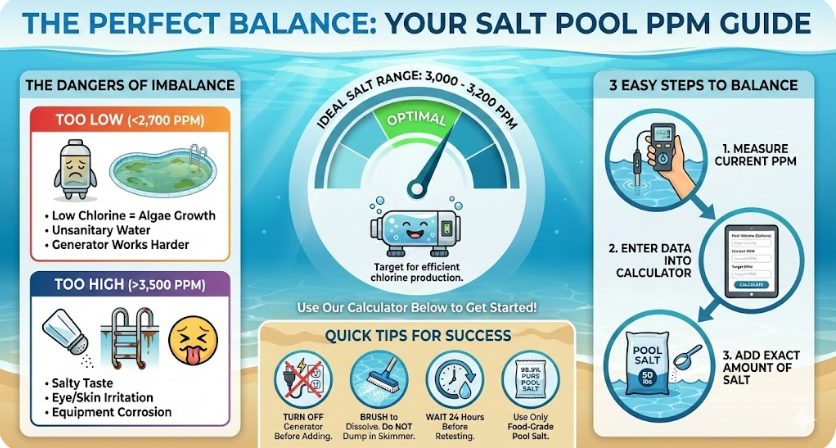Salt Pool PPM Calculator
Estimate the amount of salt to add to reach your desired pool salinity level.
Required Salt
0.00 lbs
Easy Salt Pool Calculator – Find the Right Salt PPM for Your Pool
Not sure how much salt to add? Use this simple salt pool PPM calculator to determine ideal salt levels based on pool volume, current PPM, and target PPM.
Keeping your salt pool's chemistry balanced is essential for clear water and happy swimmers. If you've ever asked, "How do I calculate how much salt to add to my pool?" or "What is the ideal salt level for my saltwater pool?", you're in the right place.
Our Salt Pool PPM Calculator is designed to answer these exact questions, helping pool owners like you maintain the perfect salt parts per million (PPM) without the guesswork.
What is the ideal salt level for a saltwater pool?
For most residential pools using a standard saltwater chlorination system, the ideal salt level is between 3,200 and 3,800 PPM. However, it's crucial to check your specific chlorinator system's manufacturer recommendations, as some brands may have a different ideal range.
Maintaining this balance is key to ensuring your system can effectively produce chlorine, keeping your water sanitized and crystal clear.

How to Calculate Salt Needed for a Pool
Manually figuring out the exact amount of salt to add can be complicated. The calculation depends on your pool's volume, its current salt level, and your desired target. The basic formula is:
- Salt Needed (in pounds) = Pool Volume (in gallons) x (Desired PPM - Current PPM) / 1000
Using our Salt Pool PPM Calculator simplifies this process. Instead of doing the math yourself, you just input three numbers:
- Pool Volume (in gallons): This is the total amount of water in your pool.
- Current Salt Level (PPM): Use a reliable test strip or a digital salt meter to get an accurate reading.
- Desired Salt Level (PPM): This is the target PPM recommended by your chlorinator's manufacturer, typically around 3,200 to 3,400 PPM.
Once you enter these values, the calculator will instantly tell you the precise number of pounds of salt you need. This eliminates the risk of over-salting, which can damage your equipment, or under-salting, which leads to insufficient chlorine production.
Common Questions Answered by a Salt Pool Calculator
- "My salt reading is 2,800 PPM. How much salt do I add to get to 3,400 PPM?"
- "What if my pool volume is in cubic feet, not gallons?" (Our calculator is in gallons, but a simple conversion—cubic feet x 7.48 = gallons—is all you need.)
- "How can I avoid adding too much salt?"
Our tool is designed to prevent these common mistakes. For example, if your current salt level is already at or above your desired level, the calculator will inform you that no salt is needed. This feature alone helps thousands of pool owners avoid unnecessary chemical additions and potential damage to their saltwater generators.
Using our calculator saves you time and money on chemicals and extends the life of your pool equipment by keeping your water chemistry perfectly balanced. It's the simplest way to take control of your pool maintenance routine.
A tool by PPMCalculator.com, built to ensure reliable, consistent, and scientifically accurate results for professionals and learners alike.
Related Calculators and Resources
